 |
||||||
 |
||||||
 |
||||||
ROAD TEST:
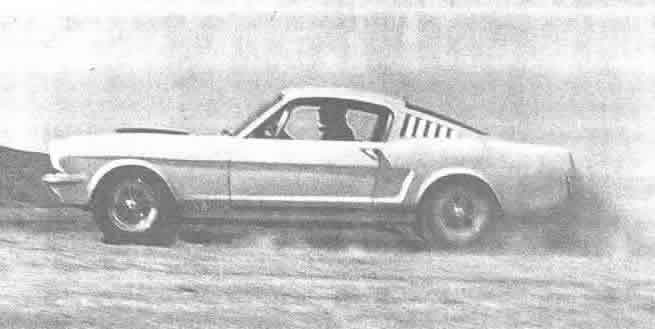
Back during the Middle Ages, that period between the time Johnny (B.C.) Hart's "gullible simp" invented the wheel and Henry Ford's arrival in the world, people used to turn to sorcerers and magicians for potions to cure their ills and allay their troubles. Most people nowadays don't believe in sorcerers, since quantum physics and new math make them technologically unemployable. But it should be reported that there is one of the old-style wizards still plying his trade, and the magic balm which he dispenses is avidly sought by a few furtive sufferers of tired blood and bland togetherness.
This modem day Merlin practices his black art not in a dank cave or hidden hovel secreted in a dark forest, but beside an ultra-modem time machine emporium. There, thousands of people daily trudge in groups of a hundred or so into the open maws of huge aluminum tubes, emerging four hours later or less in another country, another world, or at the very least another city, unaware that they had almost brushed shoulders with a source of even greater wonderment.
He is Carroll Shelby. He rebuilds cars. Correctly. He takes about 100 Mustangs each month, worth about $2300 each, and gives them his own version of a tune-up that costs another $2200.
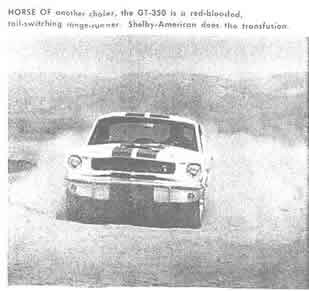 This
raw-boned Texan does a lot of things to Mustang 2+ 2 fastbacks that slide under
the ministering hands of himself and his apprentices. The cars arrive at his
magic laboratory without hoods, rear seats, or grilles, and they're all white
with black interiors. When they leave, they've gained a fiberglass hood that's
fastened by genuine racing pull-pins, a plastic rear floor for a vinyl-shrouded
spare to rest atop, and huge blue stripes along top dead center and bottom rocker
panel edge. There's a "GT-350" painted in broad strokes, so there'll
be no doubt as to what is being viewed.
This
raw-boned Texan does a lot of things to Mustang 2+ 2 fastbacks that slide under
the ministering hands of himself and his apprentices. The cars arrive at his
magic laboratory without hoods, rear seats, or grilles, and they're all white
with black interiors. When they leave, they've gained a fiberglass hood that's
fastened by genuine racing pull-pins, a plastic rear floor for a vinyl-shrouded
spare to rest atop, and huge blue stripes along top dead center and bottom rocker
panel edge. There's a "GT-350" painted in broad strokes, so there'll
be no doubt as to what is being viewed.
The most important thing which is done, because no one else does it, is relocating the inner pivot points for upper suspension arms. This little touch alone makes a vastly-needed improvement in the car, raising the roll center at the front so that the car corners flatter and more precisely. Front wheels maintains a more perpendicular attitude toward the road, regardless of body roll and side loadings, because of it.
The Shelby treatment also involves a much stouter anti-roll bar between lower front suspension arms to raise the roll moment and insure the flattest cornering possible. At the rear, a pair of traction bars are fitted to a revised axle pad, with arms running forward to a mounting point directly above the spring hanger centerline for which portions of body metal must be cut away. Extra sturdy double-acting shock absorbers complete the suspension work.
Under the hood, Shelby works more of his Cobra-derived magic. This can be liberally characterized as blueprinting an already factory-blueprinted engine. Primarily, the passages for inhaling and exhaling are given much clean-up and open-up treatment. Since these modifications, as well as more detailed explanations of suspension changes, are covered in detail elsewhere in this book, it should suffice to say that this Mustang's "350" designation is barely exaggerated from a dynamometer's standpoint.
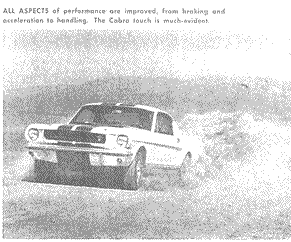 So
set up, this Mustang really rambles. Figures on the data panel illustrate vividly
the straight-line performance, but are much too inadequate to describe this
beast in action. Acceleration is enough to leave one breathless, although it
is necessary to remember that the tach needle should be kept hovering above
the 4000 mark for the most spectacular results. This is not difficult to manage,
however, with the nicely spaced ratios in its Warner Gear T-10 transmission.
So
set up, this Mustang really rambles. Figures on the data panel illustrate vividly
the straight-line performance, but are much too inadequate to describe this
beast in action. Acceleration is enough to leave one breathless, although it
is necessary to remember that the tach needle should be kept hovering above
the 4000 mark for the most spectacular results. This is not difficult to manage,
however, with the nicely spaced ratios in its Warner Gear T-10 transmission.
The latter, it might be noted, was chosen over the somewhat tougher Ford 4-speed because of it's weight-saving aluminum case. With the final drive ratio in the test Mustang the speedometer needle would easily come to rest on the 120 peg. Since the tach was registering 6000 rpm, this trued out to a back-stretch straightaway speed of 105 mph with the fat 7.75-15 Goodyear Blue Dots which were fitted.
Although this was the street version of the GT-350 (there is an even more stark and lightened competition version), it was an exceedingly loud car. A set of thin-wall tubing headers molding into straight-through tailpipe enlargements which masquerade as mufflers was the primary reason for that. So long as one doesn't deliberately bait policemen by revving up the engine in their vicinity, the system is probably legal. The dual tailpipes are bent outward to vent their wrath just in front of the rear tires and this, too, contributes to the overall noise level: The full blast of ripping exhaust assaults the driver from just below ear level.
There was one bother involved with the test car which almost made it mandatory to have a 7/16-in. box-end wrench as standard equipment. That was the tendency for the exhaust headers to work loose with even mild driving. This was attributed to incompatible expansion properties of metals in heads, headers and header bolts. As this appears, the situation will have been corrected, but on the test car at least it was necessary to refasten the headers in place about once a day. Their loosening, it goes without saying, added significantly to the decibel level inside the car.
 Noise
or no noise, however, this was a car that was designed for the man who wants
the maximum from his car. And that pre-supposes a dual-purpose car: Commute
to the office with it during the week, then paint numbers on it and race it
weekends. As it stands, it runs B Production in SCCA races and will provide
a good driver with potential winning machinery. Anyone really serious about
winning, however, would prefer the lighter and quicker competition version.
Noise
or no noise, however, this was a car that was designed for the man who wants
the maximum from his car. And that pre-supposes a dual-purpose car: Commute
to the office with it during the week, then paint numbers on it and race it
weekends. As it stands, it runs B Production in SCCA races and will provide
a good driver with potential winning machinery. Anyone really serious about
winning, however, would prefer the lighter and quicker competition version.
It is on the road course that this car belongs. Shelby modifications have guaranteed that the worst of the production car ghastlies have been eliminated. It still maintains basic understeer characteristics, but the descriptive "near neutral at speed" was never truer. It is a car with great gobs of forgiveness for driver boobery, which is just as well since it insists on one of a Ken Miles stature to extract its full potential. No little measure of this forgiving capacity is due to the huge tread patches with which the Goodyears paw the track. Side loadings of almost devastating force are required to make those tires quit working in the comer. Suffice it to say that none of our test drivers were brave enough to call this bronco's bluff. When we overcooked, as we did once on Riverside Raceway's Turn 7 a sharp downhill left-hander coming off an equally sharp rise the tires merely scrubbed off speed, sideways, while we backed off the throttle enough to regain steering control.
This was one car in which there need be no qualms about' brakes. Unfortunately, it also was one in which our test crews failed to measure our now-customary deceleration rates. Nevertheless, there was never the slightest concern with stopping power in street use. Pedal pressures were slightly higher than most people now expect, though hardly prohibitive, and fade was largely an academic question. In racing situations, however, that may not hold true although appearances to date have demonstrated no problem. One concern which remained during hard usage, however, was a legacy of the Mustang's most serious vice rear axle hop. This occurred only in severe race-course braking situations, when weight transfer effect was sufficient to let a lighter loaded rear end lift enough for the huge drums there to lock.
In tight maneuverings on very short courses or exceedingly twisting roads, the GT-350 could conceivably still be a handful. But Shelby's substitution of the quickest gears to yet appear for the Mustang steering has been a great improvement. For those who complain about an absence of road feel, this is the answer. There is definite feedback as part of the price of very quick (for a domestic car) steering and the wood-rimmed aluminum wheel borrowed from the Cobra needs a steady grip to reduce its jerky oscillations. Steering is non-power assisted, but its heaviness is not objectionable.
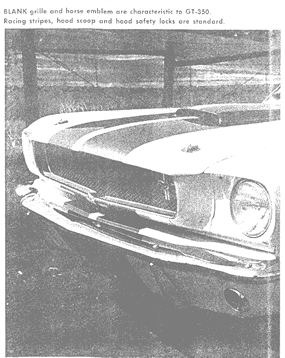 It
might be noted that engineers from both Shelby-American and Ford plunged in
to isolate and correct one problem which surfaced as first production GT-350s
began racking up mileage. Limited slip differentials, which are actually Galaxie
units, seemed to develop an inability to cope with the demands placed upon them.
This resulted in some erratic power transmission between rear wheels, which
in turn, caused various degrees of rear-end steering. The test car, though afflicted
with this trauma, didn't persevere beyond the annoying stage, but it was disconcerting
in its presence.
It
might be noted that engineers from both Shelby-American and Ford plunged in
to isolate and correct one problem which surfaced as first production GT-350s
began racking up mileage. Limited slip differentials, which are actually Galaxie
units, seemed to develop an inability to cope with the demands placed upon them.
This resulted in some erratic power transmission between rear wheels, which
in turn, caused various degrees of rear-end steering. The test car, though afflicted
with this trauma, didn't persevere beyond the annoying stage, but it was disconcerting
in its presence.
Little in driver comfort has been sacrificed by the GT-350 over that of the off-the-shelf 271-HP Mustang. The same carpeting and bucket seats among the most comfortable and secure in domestic production are used. The flatter (and slightly smaller in diameter) steering wheel improves driver position. And the Air Force seat belts, even if less stylish, are vastly greater security than Linus blankets.
Still, despite almost immeasurable improvement in balance and handling and
cornering and braking, we came away from the GT-350 with somewhat mixed emotions.
It out-performed the last fuel injected Corvette Sting Ray which CL tested,
for quite a few dollars less. That, of course, is certainly one recommendation.
But the cost is not measurable in dollars to many, and the difference is between
gentility and boorishness, between manners and manhandling, between the sophisticated
and the strident. On balance, however, it really comes down to the name of the
game, and that is To Win. That's our game, too, and Shelby and Ford are playing
it with the GT-350. This is one time we'll have to close the textbooks, ignore
all pretensions, and shout: I'll take it, I'll Take It! Ol' Wizard Shel has
us in his spell. ![]()
Tests courtesy of "Mustang A Complete Guide a Car
Life special Edition", printed 1965 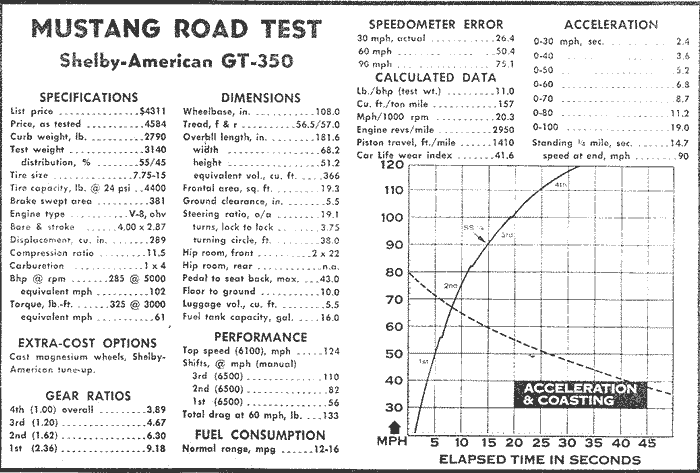

Website Design by Hansen IT Solutions
Any Questions about the cars on this site or about importing other
cars please email [email protected]